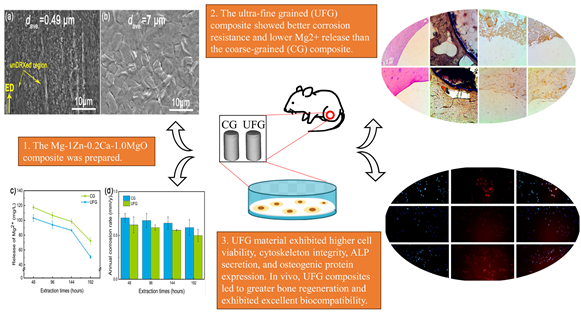In vitro and vivo biocompatibility and degradability of low-alloyed Mg-Zn-Ca-MgO composite as bone repair biomaterials
DOI:
https://doi.org/10.55713/jmmm.v34i1.1910Keywords:
magnesium alloy, Corrosion, Bone regeneration, Cell-compatibilityAbstract
Abstract
Magnesium alloys have gained attention as biodegradable bone repair biomaterials. Unlike non-biodegradable materials like titanium and tantalum, biodegradable implants offer advantages in promoting bone healing and minimizing chronic inflammatory reactions. However, the impact of the implant's degradation on the osteogenic environment remains a concern. The Mg-Zn-Ca-MgO composite, being biocompatible and containing osteogenic ions, is a promising candidate. This study assesses the degradability and in vitro/in vivo biocompatibility of two Mg-Zn-Ca-MgO composites with varying degradation rates. The Mg-1Zn-0.2Ca-1.0MgO composite was prepared, and leaching solutions were created following standard protocols. MC3T3-E1 cell cultures were conducted to assess cell toxicity, alkaline phosphatase (ALP) staining, cytoskeleton morphology, and osteogenic protein expression. In vivo biodegradation and bone regeneration capacity were evaluated in rat femoral condyles. Benefiting from the more protective corrosion product layer on the surface, the ultra-fine grained (UFG) composite showed better corrosion resistance and lower Mg2+ release than the coarse-grained (CG) composite. UFG material exhibited higher cell viability, cytoskeleton integrity, ALP secretion, and osteogenic protein expression. In vivo, UFG composites led to greater bone regeneration and exhibited excellent biocompatibility. The UFG Mg-Zn-Ca-MgO composite demonstrates enhanced biocompatibility, corrosion resistance, and bone regeneration potential. This study highlights the importance of controlling Mg ion release for optimal bone healing in biodegradable materials.
Downloads
References
M. P. Staiger, A. M. Pietak, J. Huadmai, and G. Dias, "Magnesium and its alloys as orthopedic biomaterials: a review," Biomaterials, vol. 27, no. 9, pp. 1728-1734, 2006.
N. Singh, U. Batra, K. Kumar, N. Ahuja, and A. Mahapatro, "Progress in bioactive surface coatings on biodegradable Mg alloys: A critical review towards clinical translation," Bioact Mater, vol. 19, pp. 717-757, 2023.
Y. Chen, Z. Xu, C. Smith, and J. Sankar, "Recent advances on the development of magnesium alloys for biodegradable implants," Acta Biomater, vol. 10, no. 11, pp. 4561-4573, 2014.
S. Y. N. Wang, H. Shi, Y. Song, H. Sun, Q. Wang, L. Tan, and S. Guo, "Magnesium alloys for orthopedic applications: A review on the mechanisms driving bone healing," Journal of Magnesium and Alloys, vol. 10, no. 12, pp. 3327-3353, 2022.
Y. H. Chang, C. C. Tseng, C. Y. Chao, C. H. Chen, S. Y. Lin, and J. K. Du, "Mg-Zn-Ca alloys for hemostasis clips for vessel ligation: In Vitro and In Vivo studies of their degradation and response," Materials (Basel), vol. 13, no. 13, 2020.
F. Feyerabend, F. Witte, M. Kammal, and R. Willumeit, "Unphysiologically high magnesium concentrations support chondrocyte proliferation and redifferentiation," Tissue engineering, vol. 12, no. 12, pp. 3545-3556, 2006.
Z. Y. Fan, Y. B. Zuo, and B. Jiang, "A new technology for treating liquid metals with intensive melt shearing," Materials Science Forum, vol. 690, pp. 141-144, 2011.
M. D. S. Thanka Rajan, A. Arockiarajan, "In vitro assessment of corrosion resistance and biocompatibility of tantalum-niobium oxide surface-functionalized Mg alloy," Materials Chemistry and Physics, vol. 301, p. 127560, 2023.
D. Zhao, K. Yu, T. Sun, X. Jing, Y. Wan, K. Chem, H. Gao, Y. Wang, L. Chen, X. Guo, and Q. Wei, "Material–Structure–Function integrated additive manufacturing of degradable metallic bone implants for load-bearing applications," Advanced Functional Materials, vol. 33, no. 16, p. 2213128, 2023.
Y. Wang, Y. Fan, and H. Liu, "Macrophage polarization in response to biomaterials for vascularization," Annals of Biomedical Engineering, vol. 49, no. 9, pp. 1992-2005, 2021.
M. Wang, Y. Yu, K. Dai, Z. Ma, Y. Liu, J. Wang, and C. Liu, "Improved osteogenesis and angiogenesis of magnesium-doped calcium phosphate cement via macrophage immunomodulation," Biomaterials Science, vol. 4, no. 11, pp. 1574-1583, 2016.

Downloads
Published
How to Cite
Issue
Section
License
Copyright (c) 2023 Journal of Metals, Materials and Minerals

This work is licensed under a Creative Commons Attribution-NonCommercial-NoDerivatives 4.0 International License.
Authors who publish in this journal agree to the following terms:
- Authors retain copyright and grant the journal right of first publication with the work simultaneously licensed under a Creative Commons Attribution License that allows others to share the work with an acknowledgment of the work's authorship and initial publication in this journal.
- Authors are able to enter into separate, additional contractual arrangements for the non-exclusive distribution of the journal's published version of the work (e.g., post it to an institutional repository or publish it in a book), with an acknowledgment of its initial publication in this journal.












